SA Country Fire Service Promotions Unit - History Section
Promoting the Historical foundations of the Service
Montacute Brigade
- 1942 to Present
In 1904, a resident reportedly started a fire in Pinkerton's Gully from a lit cigar. This cost the owner dearly, as he had to sell his property to pay for the damage caused. This was a catalyst for the early formation of fire-fighters in the district, but there was no specific organization and no leadership. Residents obeyed the law of "head for the smoke" and did whatever was required.
During World War Two, Mr. Vin Schultz and Mr. Ewin Possingham were appointed Special Constables, and were a driving force for the formation of a structured team.
On December 26th 1942, at the Montacute Institute, a meeting was held to consider the formation of a Fire Fighting Association. The convenor of the meeting, Mr. A. Trebilcock, explained the object of the meeting and it was resolved to form an association to be called the Montacute Fire Fighting Squad. The inaugural office holders were as follows: Chairman Mr. A. Trebilcock Secretary Mr. R. Hunter Treasurer Mr. W. Winter Committee Members Mr. S. Ross Mr. J. Trebilcock Mr. B. Trebilcock Mr. G. Gepp Mr. V. Schultz A call for a preliminary list of members resulted in 34 people joining the Association. It was moved and seconded that funds be raised by voluntary contributions. A list of equipment in the hands of members indicated that they had available 13 spray pumps, 13 drums and 2 'steel brushes'. It was also proposed and seconded that five volunteers be called for to bring water by motor trucks immediately there was an alarm. These volunteers were Mr. W. Winter, Mr. S. Smith, Mr. A. Sparnon, Mr. W. Smith and Mr. E. Greene. Considerable discussion took place among many matters concerning the organization, particularly water supply and operational boundaries. Further discussion was adjourned to a second meeting.
By the end of the second meeting, membership of the Association had reached 50 people. E.F.S. Emblem EFS Emblem, which was used from the formation of the EFS in 1947 up until the formation of the CFS in 1977. In 1947 the South Australian Emergency Fire Service (EFS) was established, (later to become the Country Fire Service (CFS)), and so the Montacute Fire Fighting Squad became the Montacute EFS Brigade.
The wind-up of the Civil Defence after the Second World War left the State Government with a number of redundant trailer pumps and fire-fighting equipment. Late in 1947, the Montacute EFS Brigade was supplied with a Kelly and Lewis trailer mounted pump from the state government. Two teams were formed to operate the pump, referred to as the No. 1 and No. 2 team. The No. 1 team consisted of Vic Whelan, Phil Ford, Eric Greene, Harvey Gepp, Frank Trebilcock and David Whelan. The No. 2 team consisted of Bert Trebilcock, F.A. Greene, Colin Trebilcock and C. Smith. The trailer pump was towed to fires by private vehicles, one of which was Mr. Eric Greene's G.M. Maple Leaf Truck. In 1950, the Brigade procured its first radio sets. In the same year, on July 22, it also competed in a competition held at the Belair National Park, which it won. The winning team consisted of Mr. V. Whelan (captain), Mr. E. Greene (who supplied his utility to tow the portable trailer pump), Mr. F. Ford and Mr. D. Whelan. Montacute then challenged all comers, the winner to be decided in a competition to be held at the Wayville Showgrounds on September 9th. Mr. F.A. Trebilcock substituted for Mr. F. Ford, who had sustained an injury. Montacute won this competition also, and went on to successfully compete in coming years winning many more times.
Montacute's successes between 1950 and 1964 are listed below. From 1961 onwards, the current drill was used. Portable Pump Alarm Race 1st Placings Year Team Time (seconds) 1950 Montacute 42.8 1953 Montacute 39.0 1956 Montacute B 36.0 1958 Montacute 29.0* 1959 Montacute 35.0 1960 Montacute No. 1 28.0* 1961 Montacute No. 1 22.6* 1962 Montacute No. 1 40.0 1964 Montacute No. 1 39.0 * Special drill movements due to wet conditions.
In 1951 a truck was purchased by the Brigade from Mr. F. Ford to tow the trailer pump. It is possible that this truck was a 1924 Morris Cowley. A siren was also installed to alert members and residents alike when a fire was in progress.
The Black Sunday bushfires of 1955 were attended by the Montacute EFS Brigade. St. Pauls Church on Church Road, Montacute, was destroyed during these fires and was later rebuilt.
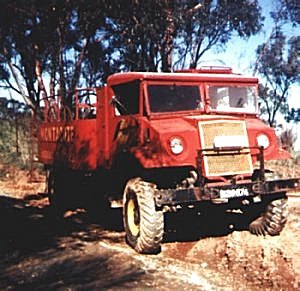 In 1957, the Brigade aquired its first dedicated fire appliance, a 1941 Cheverolet Blitz C-30 for the sum of £ 110. The body was constructed by A.J. Stock Bodybuilders at the cost of a further £ 80. In 1958 a shed was completed on Montacute Road, which still forms part of the current Fire Station, to house the new vehicle. The shed was completed for approximately £ 200 and was opened by the Director of the SA EFS, Mr. Fred Kerr.
Khaki Shoulder Patch
Early khaki shoulder patch (1977 to 1982).
In 1961, after a faulty exhaust on a petrol tanker caused five fires along Gorge Road, the Brigade was out for three days and two nights continuously. The tanker was eventually stopped by a member of the public. The need for a second vehicle in the district had been realized for many years.
In 1957, the Brigade aquired its first dedicated fire appliance, a 1941 Cheverolet Blitz C-30 for the sum of £ 110. The body was constructed by A.J. Stock Bodybuilders at the cost of a further £ 80. In 1958 a shed was completed on Montacute Road, which still forms part of the current Fire Station, to house the new vehicle. The shed was completed for approximately £ 200 and was opened by the Director of the SA EFS, Mr. Fred Kerr.
Khaki Shoulder Patch
Early khaki shoulder patch (1977 to 1982).
In 1961, after a faulty exhaust on a petrol tanker caused five fires along Gorge Road, the Brigade was out for three days and two nights continuously. The tanker was eventually stopped by a member of the public. The need for a second vehicle in the district had been realized for many years.
Midway through 1965, the younger members of the Brigade purchased and donated to the Brigade a Ford Utility to be used for training, competitions and as a second vehicle. A pump was donated and was also fitted to the vehicle. Owing to the poor mechanical state of the vehicle however, it was never pressed into service. Some equipment was salvaged from it before it was sold in 1966.
The Brigade pressured the District Council for a new vehicle to cover the Castambul area in 1967 but was told that no funds were available. It was not until 1972 that funds were made available by the Council to purcahse a new unit for the Norton Summit/Ashton EFS This then paved the way for Montacute to purchase Norton Summit/Ashton's 1960 Landrover for the sum of A$800. For many years, this vehicle was housed at the home of founding and life member Mr. Frank Schulz, at Bachelors Road, Castambul.
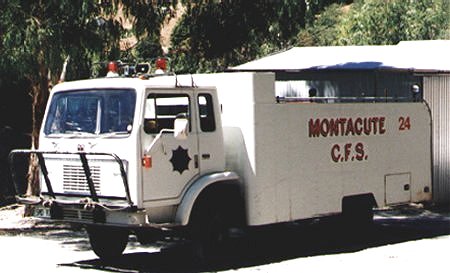 Before too long, it became apparent that the ageing Landrover was inadequate as a Quick Attack Vehicle. At about this time, the Brigade also foresaw the need to replace the ageing Chevrolet Blitz. This led to the aquirement late in 1976 of an International Acco 510A.
Before too long, it became apparent that the ageing Landrover was inadequate as a Quick Attack Vehicle. At about this time, the Brigade also foresaw the need to replace the ageing Chevrolet Blitz. This led to the aquirement late in 1976 of an International Acco 510A.
It was a 4WD powered by a 5.0 litre V8 petrol engine coupled to a four-speed manual transmission. The appliance was constructed by a local firm, Carey Gully Engineering (now Australian Fire Company) and was fitted with a 1800 litre tank and a 9 hp Briggs and Stratton electric start petrol engine driving a GAAM Mk 100 pump. It underwent many changes during its service history, including the addition of a crew protection cab, and was eventually fittted with a Darley 1.5 AGE pump driven by an 18 hp Briggs and Stratton electric start petrol engine.
This appliance was commissioned into service on the 4th of March 1977 by Mr. Peter Malpas, Assistant Director of the then SA Emergency Fire Service (later that year to become the Country Fire Service).
Nineteen seventy-seven saw the proclamation of the Country Fires Act 1977 which established the SA Country Fire Service in place of the Emergency Fire Service. This resulted in the change of name to Montacute CFS Brigade.
Attending a fire in 1978, the timber seat and tray on the Chevrolet Blitz caught alight from intense heat. Overhead, high tension powerlines (132 kVA) arced through thick smoke. Up until then, the authorities had declared that this was not possible. All of the brigade's vehicles saw service during the Ash Wednesday I bushfires of 1980 and again during the Ash Wednesday II bushfires of 1983, when the Brigade was out continuously from the 16th of February to the 18th of February. At these fires the Blitz sustained damage to its fuel system, and difficulty in finding spare parts led to its decommisioning in 1986. It was sold to a local resident for A$500 and still remains in the district.
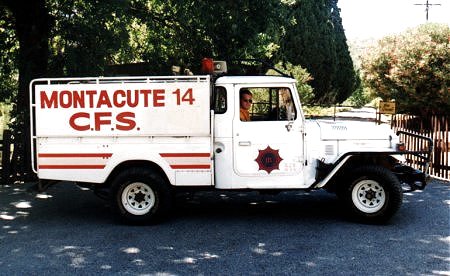 Meanwhile, the Landrover was replaced by a Toyota Landcruiser FJ 45 , which was obtained late in 1982 for a cost of A$8117. This vehicle was built up by Brigade member Mr. B.J. Trebilcock and was commissioned upon completion in 1984. It was a 4WD vehicle powered by a
4.2 litre six-cylinder petrol engine with a four-speed manual transmission. It had
the same Honda G 200 petrol motor and NS 45A Hatsuta pump combination as the current
Montacute 14 appliance, but did not have the second pump. Although the cab-chasis
was purchased for A$8117 in 1982, much of the vehicle was designed and built by
Mr. B.J. Trebilcock, a local resident and Brigade member, so the final cost of the
vehicle is difficult to judge. Much of the equipment from this vehicle, which was
retired in 1996, went onto the current Montacute 14 appliance.
Meanwhile, the Landrover was replaced by a Toyota Landcruiser FJ 45 , which was obtained late in 1982 for a cost of A$8117. This vehicle was built up by Brigade member Mr. B.J. Trebilcock and was commissioned upon completion in 1984. It was a 4WD vehicle powered by a
4.2 litre six-cylinder petrol engine with a four-speed manual transmission. It had
the same Honda G 200 petrol motor and NS 45A Hatsuta pump combination as the current
Montacute 14 appliance, but did not have the second pump. Although the cab-chasis
was purchased for A$8117 in 1982, much of the vehicle was designed and built by
Mr. B.J. Trebilcock, a local resident and Brigade member, so the final cost of the
vehicle is difficult to judge. Much of the equipment from this vehicle, which was
retired in 1996, went onto the current Montacute 14 appliance.
In the same year, the station was extended to include an additional truck bay so that the three vehicles could all be housed together, as for some years prior to this the Blitz was housed in Mr. I. Sparnon's shed. In 1987 the station was broken into resulting in A$2000 worth of damage and stolen equipment. Following this, the station recieved upgrades to its doors, locks and exterior lighting. It was further upgraded in 1992 to include a meeting room/radio room in place of the redundant central truck bay. In 1996, a small kitchen area was completed.
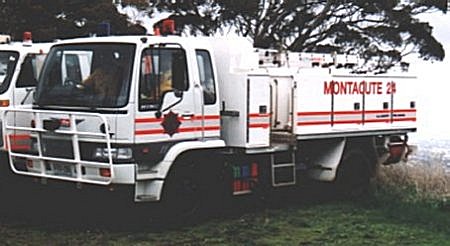 In 1996, the International Acco 510A was sold and replaced with a standard Hino FT3W 24 type appliance ( Montacute 24 ).
In 1996, the International Acco 510A was sold and replaced with a standard Hino FT3W 24 type appliance ( Montacute 24 ).
Montacute 24 is a Hino FT3W Super Kestrel 4WD vehicle, powered by a 6.0 litre six-cylinder inline diesel engine with a six-speed manual transmission. It carries 2000 litres of water, and hence the callsign Montacute 24 ( 2 000 litre, 4 wheel drive). All SA CFS vehicles are named in this way. The vehicle seats a crew of six, three in the front cabin and three in the crew protection cabin on the rear of the appliance.
The appliance is equipped with a GAAM Mk 3000D 2-stage centrifugal pump driven by a Hatz 1.7 litre air cooled diesel motor. The pump discharges to two 64 millimetre outlets, two charged lines on reels (30 metres of 25 millimetre diameter and 60 metres of 19 millimetre diameter), a front mounted spray bar, and also two short charged lines for crew protection. Also fitted is a foam proportioning system capable of discharging AFFF light water foam or BFFF Fire Break bush-fire fighting foam.
Montacute 24 carries a Rural 2 stowage kit which is the base standard for all SA CFS appliances. This consists of basic firefighting equipment such as canvas lines, branches, a standpipe, rakehoes and hand tools, knapsacks, a driptorch, fire extinguishers, ropes, a first aid kit, torches, road cones, a chainsaw, toolkit and an extension ladder. This appliance was aquired in 1996 and should not need to be replaced until 2016.
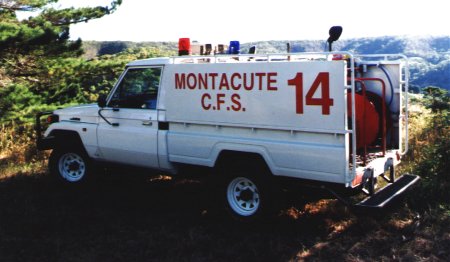 Later that year, the Toyota Landcruiser FJ 45 was also replaced from Brigade funds with a newer model Landcruiser HZJ 75 ( Montacute 14 ).
Later that year, the Toyota Landcruiser FJ 45 was also replaced from Brigade funds with a newer model Landcruiser HZJ 75 ( Montacute 14 ).
Montacute 14 is a Toyota HZJ 75 Landcruiser 4WD vehicle, powered by a 4.2 litre six-cylinder inline diesel engine with a five-speed manual transmission. Although it only carries 450 litres of water, it is still classed as a 14 (for 1 000 litre, 4 wheel drive). It makes up for its limited "firepower" with its higher speed and small size that enables it to traverse more inaccessible terrain."
Montacute 14 is equipped with a Honda G 200 petrol engine driving a NS 45A Hatsuta high pressure spray pump. The pump feeds 180 metres of 9.5 millimetre diameter high pressure hose. Although only of small capacity, this hose length is extremely useful for reaching up or down steep inaccessible hillsides (but somewhat of a task to wind back up!) The vehicle also has a second pump - a Davey 93106-0 powered by a Honda GX 160 petrol motor, which discharges to 30 metres of 13 millimetre line or a 25 millimetre outlet for use when more greater flow is required. There is an additional short length of charged line for crew protection.
Montacute 14 carries a small stowage kit consisting of basic tools, a chainsaw, knapsack, rakehoes and hand tools, a first aid kit, a torch and fire extinguishers. This appliance is currently on a vehicle replacement programme. The tray and equipment are retained and fitted to a new cab chasis every two years. The cab chasis has recently been replaced with a vehicle of identical specifications.
This vehicle is now on a two year vehcle replacement program, and was recently replaced again with a new cab chasis of the same model. The Brigade hopes to move into new premises in the near future, once a suitable site is found, as the current premises have been deemed inadequate under CFS legislation.
This information has been sourced from the Brigade website at this address
Brigade Stations
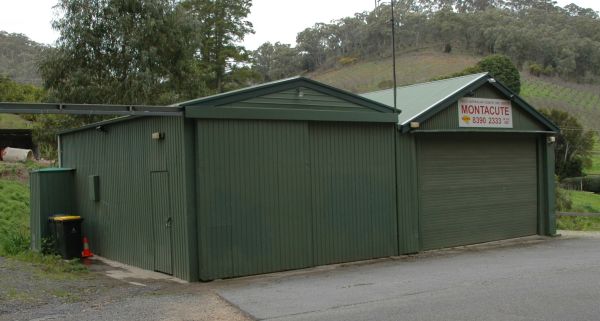
1958 to Present - 791 Montacute Road, Montacute
Photographer, CFS Promotions Unit - Sep 2010
Google Map reference - Longitude 138.736310 Latitude -34.892432
Captains
Life Members
SACFS Promotions Unit
http://www.fire-brigade.asn.au